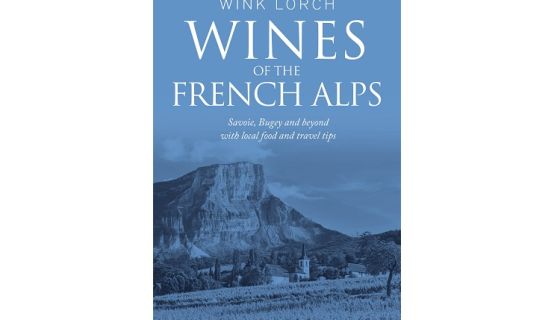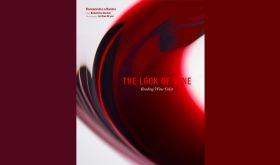2 December 2019 Tam's end-of-year book reviews are some of our most popular features. This year, at your suggestion, we're starting to publish them rather earlier than usual with this assessment of a new, self-published offering from the author of a fine book on Jura wines. Wink published this crowdfunded book herself. (See How to publish your own wine book from 2010 and Richard's 2016 observations on self-published wine books from his Master of Wine research paper.) See this guide to our book reviews.
Wines of the French Alps
Savoie, Bugey and beyond with local food and travel tips
Wink Lorch
Published by Wine Travel Media (order it from winetravelmedia.com; it's not widely available)
ISBN 9780992833114
£25
Books are like schoolteachers. I won’t say anything about the bad ones (books or schoolteachers) but the good ones can generally be put into two categories: the ones that inform with accurate facts and figures, clear communication, logical presentation; and the ones that galvanise.
The latter have the accurate facts and figures, clear communication, logical presentation. But they also have something else. They are written with the electric current of conviction. They are change-makers.
Wink Lorch’s Wines of the French Alps is a book about just 4,600 ha (11,300 acres) of scattered Alpine vineyards making less than 0.5% of the wine produced in France. It’s a region so small it shouldn’t matter. But Lorch has written a book so big that, by the end, you’ll know that it really does matter.
A lifelong skier, Lorch came across wines from Savoie in the mid 1980s and for the last 20 years has been tasting, visiting and getting to know the wines and the people from these Alpine regions. She even bought a second home in Haute-Savoie.
She’s justifiably earned her reputation as the leading light on the wine regions of Jura and Savoie, winning the André Simon Award for her book Jura Wine in 2015. No one has devoted as much time and energy to these unusual and little-known mountain vineyards as Wink Lorch has.
Looking at five regions – Savoie, Bugey, Isère, Hautes-Alpes and Diois (home of Clairette de Die) – Lorch doesn’t merely plough through the usual formula of history, geography, production, people and product.
Between stories of yeast whisperers, white gold, glacier-carved soils and forgotten ancient grape varieties rescued from extinction by stubborn visionaries, she quietly pegs out the strengths and beauties of the vineyards and their wines, whilst not flinching from their weaknesses and challenges.
That is a rare thing: to love a region, live in a region, know the vignerons well and yet be able to stand back objectively and mete out some pretty tough observations. Lorch is not sharp or waspish, but her honesty shines through. Knowing that the producers are going to hear about it, if not read it themselves, it takes a certain amount of integrity and steel to write things such as, ‘my last tasting of the red cuvées was disappointing …’, and, ‘I do wonder if the wine quality lives up to its price or the promise of the packaging – the sumptuous rooms may have taken up an unfair share of attention so far in this ambitious project.’
But not for a minute does one get the impression that she is gratuitously looking for faults. Her profiles of 120 vignerons are warm, full of admiration and respect, generous with praise yet utterly without flattery.
Her toughest criticism, in fact, is reserved for the official regional organisations. They are ‘stuck in the 20th century’, and ‘increasingly out of tune with consumers’ interests’. I could almost feel her anger flare when she describes how vignerons rescuing rare grape varieties and abandoned vineyards, lowering yields and working in a more environmentally protective way are being penalised by having to designate their wines Vin de France, while those in high places argue over whether there should be a grand cru system.
It goes without saying that her knowledge of the region is formidable – if not surprising – and this book is rich pickings on every page. The chapter on grape varieties looks in detail at 36 of the 52 varieties found in the regions, some of them grown nowhere else on the planet. The names tumble out of the pages like rolls of exotic silks under the hands of a cloth merchant: Jacquère, Altesse, Gringet, Bergeron, Molette, Verdesse, Persan, Mondeuse, Poulsard … you can feel the heritage.
If you want to get to grips with the PDO regulations, this book probably has more detail (and makes more sense!) than INAO. But if you’re more interested in food and wine matching, there are two chapters on Alpine cheeses, cured meats and other mouth-watering mountain fare, from mushrooms and lake fish to honey and gateau. There is a third chapter on the beers, spirits and liqueurs of the mountains.
I was particularly impressed with the gentle but persistent focus she kept on sustainability: environmental, social and economic. She is clearly very aware of the impact that wine is having on the environment, the community and the long-term viability of the region, both positive and negative. How people are farming, where there are divisions and collaborations, where the next generation is involved or walking away, and the prices of wines (from overpriced to underpriced); all these aspects come under her thoughtful pen time and time again.
And thanks to Mick Rock and Brett Jones (Wink Lorch’s partner who died in April 2018, part-way through the writing of this book, after a long battle with cancer), the book is full of the visual colour, grandeur, beauty and humanity of the Alps.
Academic textbook, research resource, travel guide, wine guide, this is a book that had me reaching for maps, Google-Earthing villages, looking up cheeses, ordering wine and searching flight schedules. It was when I started reading producer profiles to my husband over dinner that I realised I’d dropped my critical reviewer’s hat somewhere over the edge of a steep precipice.
Ah well, too far to go fetch it now.














